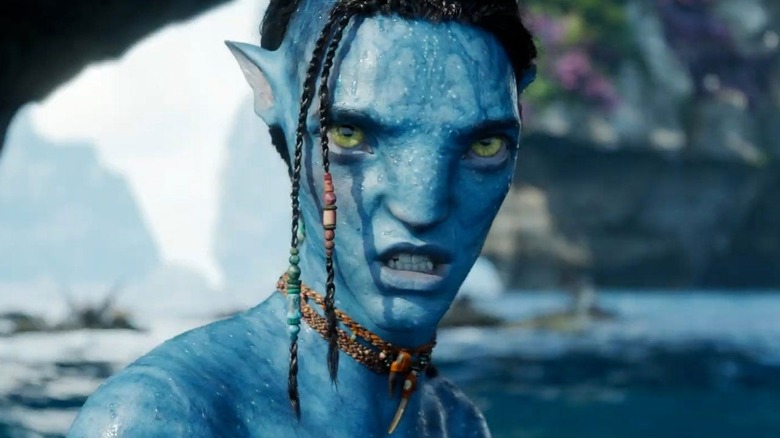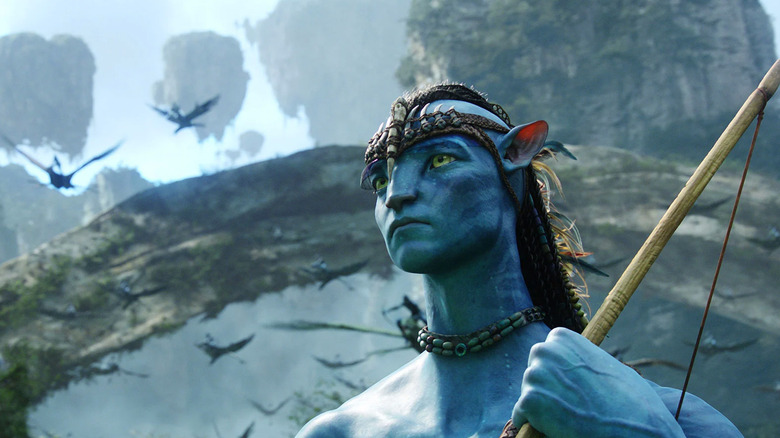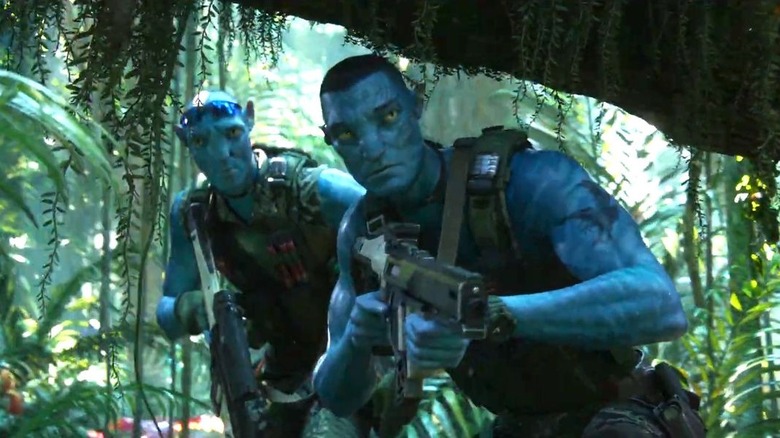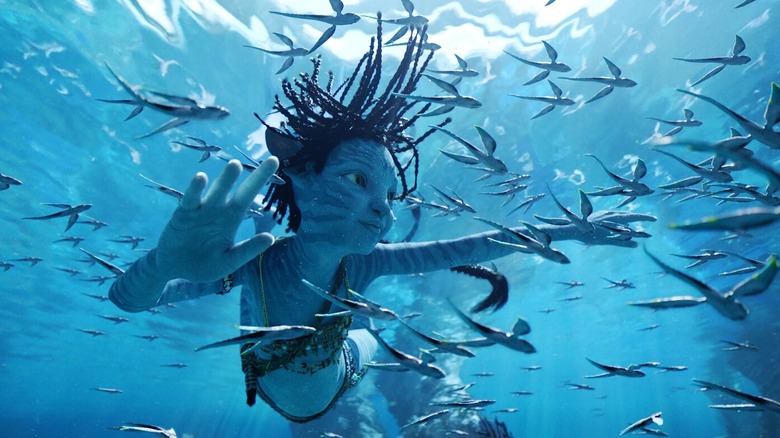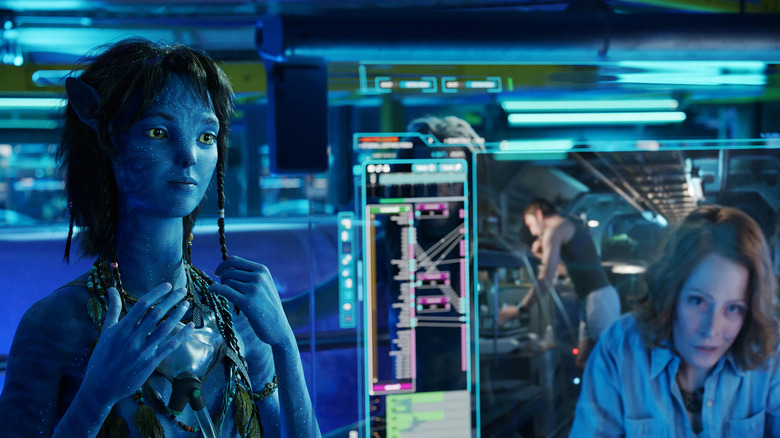Avatar: The Way Of Water VFX Supervisors On How Kiri Was Created And Much More [Exclusive Interview]
Ever since Gollum in "The Lord of the Rings: The Two Towers" blew audiences away by presenting a fully realized and believable digital character, it was clear that performance capture technology would be here to stay. Fast forward 20 years, and the technology has grown to such dizzying heights that there seems to be no limit to what the combined efforts of effects artists and performers can accomplish when it comes to creating new characters.
As proof, "Avatar: The Way of Water" doesn't just pick up the adventures of the Na'vi from the already impressive first film, but introduces new elements like the 14-year old Kiri (played by the 73-year old Sigourney Weaver) and the reborn-as-a-9-foot-avatar Colonel Quaritch (Stephen Lang), who plays scenes in real time with the shorter, 5-foot human General Ardmore (Edie Falco).
I had the chance to speak to two of the men responsible for accomplishing these visual feats, Academy Award nominee Daniel Barrett and BAFTA nominee Wayne Stables, the Senior Animation Supervisor and Visual Effects Supervisor for Weta FX, respectively. They spoke about working with actors to create such lifelike characters, putting them into believable environments, working with the Spydercam, and just how they pulled off a de-aged alien character with Kiri.
Note: This interview has been lightly edited for clarity and brevity.
'Every audience member is an expert in facial expression'
If cinema itself is a magic trick, then this is kind of the magic trick on top of the magic trick. These people aren't real, but there's a reality to them that you folks bring. Speaking as someone coming from an acting background, there's this idea of, "Oh no, these animators are going to come and take our acting away from us." There's that fear that's even still there in terms of de-aging technology. But there's still such a big element that the actors bring to these performances. What is the process like for you in terms of balancing that?
Barrett: Look, I have an incredibly talented animation team. What we don't do is a more traditional kind of animation. Getting into this, I loved it because I was a bit shy, but I kind of liked entertaining. I was the actor that didn't have to stand on stage. I could do things and I could put them onto characters. Now that's not what this is, because these performances are guided by others. The animators are not acting when they do this work. Almost our contract is that what we do is we bring the performances through.
It's an amazing cast. Every single one of them are better actors than me. And so the talent of the team, I think, is most truly expressed when we know we've brought everything through. And we have incredible eyes, people that can look at performances. I like to think that what the best animators on the team can do is they can see things that the audience can't actually see, but that the audience will feel, because every audience member is an expert in facial expression. Every audience member has been an expert since they were six months old.
Stables: I can categorically tell you, by the way, they do, because you guys talk about stuff that I just don't see. So these guys are saying, "This needs to change," and I didn't see that. I'm absolutely going to trust it, but it's an interesting thing.
Barrett: Yeah, it's what we trade in; we'll look at a performance of an animated character and we'll look at the matching performance of the actor shot through witness cameras. And there are two ways of looking. You can look at it and go, "Is everything moving the same?" The more important way of looking is, "Does it feel the same?" And as soon as the answer to that is no, that's when the investigation begins. That's when you start looking at what you've missed.
Sometimes it can be the most subtle thing. It can be just the height of the eyelid, or maybe we just missed the flicker of an eyelid, or maybe it was the way that the mouth was set not exactly like we had it. So I personally would like to think that what you are seeing on screen is exactly what was given by the actors. And that factor sits quite happily with another one, which is that our animation team is incredibly talented and it takes a lot of talent and a lot of work to get that right.
Finding the focus in every shot
Wayne, your primary focus on the film was on environments, correct?
Stables: Well, so my job is to ultimately just deliver the whole show with all the characters and things like that, so I'm in there from once the animation goes through, but a lot of environment work there, yeah. To be fair, I guess you could say, yeah.
I have no concept about how the process of making this movie worked in terms of, was it always the same thing for every shot, where it starts with a filmed element, or was it starting sometimes with something animated?
Stables: So, Jim has a process that he goes through where he will have his team over at Lightstorm — say he's going to shoot a scene, you know, Quaritch in the jungle having a discussion. They'll know it's going to take place in a jungle, so they construct that kind of as more low resolution proxy assets. He goes into it. He sort of gets the rough motion often with, if it's not the actual actors, it'll be a standard troupe of people who will start to block out the action. He'll work out, "Okay, this is kind of where I'm going to want to roughly shoot this, but we need another mountain here or we're going to need to clear this away, or we're going to need to do this, or let's put a log here." They go through that process. Then they'll build that environment. Then they'll bring the actual performers in and they'll actually do the capture with it.
At that stage, they're kind of alongside the environments. He's not really looking at his cameras too much at that point in time. He's really after performance. He's making sure that everything is going to work. And then once they've captured the motion, he goes back and he does step three, which he does his camera pass. So he goes onto his virtual cameras and now he's got the things and he might adjust timing or he might adjust position. He'll then do some more work to the environment so that composition and narratively, his shots are working and all makes sense. And then that's what's turned over to us, so by the time I see something and Dan sees stuff, there has been so much thought process that has gone into it. The funny thing is, though, with what he turns over to us, is that if you match it sort of perfectly, you can very quickly get yourself into trouble as well, because sometimes there was maybe limitations of what they had to work with.
So the thing I really enjoyed, and this is what I always talk to my crew about, that we would go into the theater and actually play these templates in the theater on the big screen. And the challenge was, stand back, de-focus your eyes slightly and for every single shot, ask yourself what is he narratively saying about the shot? What is the focus? It's like, "Oh look, this shot's about those viperwolves and graphically he has this big beam of light going behind them so that it stands out. And he's put that beam of light there and not there because he doesn't care about the plants over here. It's a shot about the viperwolves." So we get a huge amount of that coming through as our starting point. But as I said, you've kind of then got to sit back and try the art form of trying to look through it through Jim's eyes sometimes in terms of what he was seeing there.
And I do think it's a really ... we talk about it a lot. We talk about characters and story and stuff like that. But if you say to yourself, if you watch any one of those shots, and you say, "What is the story element here? What is it?" You will never go wrong. Everything he does is in service of the story. And then we take the work from the artwork with the art departments and things like that to take his world as he's built it and try and lift it up to a level where it stands up on the big screen because that's what audiences expect, which is often not quite as creative.
It's just building stuff up to a certain level. I don't want to say it becomes a technical exercise, because that's not fair and it's not true. But you sort of know what I mean. It's kind of like a lot of — he's already given us so much of his creative thought in terms of what he wants something to look like. If he wants a big building there, he's already showing us that he wants a big building there.
Barrett: Well, that's when the exploration should happen, right, where everything's a little pared down.
Stables: But at the time he gives us something, it's an edit of his film by the time we see it, which is unbelievably great to work with.
Barrett: Yeah, I think I saw the film maybe four years ago. I think it was about four and a half hours long.
Oh, wow.
Stables: Yeah, so for the first "Avatar" I watched play through, must have been nearly two years before it was delivered and it really didn't change very much from what it was. So to us, we're really, really lucky on that one.
So in essence, y'all are watching kind of a previz?
Stables: It is. It's previz, but previz with the very heavy hand where a director has gone and it's not just — it's more than just a sort of perhaps sketched out ideas.
Barrett: It's not just action and camera.
Stables: Yeah, it's not just action. When we get a template turned in to us, we are seeing his film. It might be a slightly rougher version of his film, in terms of visual, but we are seeing...
Barrett: The lighting's there, right. It's gestural, but it's all there.
Stables: Yeah, exactly, in some ways the performance is there and things like that. And what's nice about that when he does this stuff, because the same as any actor or a performer on a stage where maybe they'll walk into their key light or something, he's worked that stuff out. So we kind of know where we're going.
'He's actually a very traditional filmmaker'
I would love to know more about the Spydercam.
Stables: I think Spydercam is actually a slightly misleading name, but they call it Spydercam. But, basically imagine you've got a set like this and you slice off the ceiling and you rig a whole bunch of cables. Well, it's just not quite a whole bunch. There's cables coming in from towers on either [side], and then what you can do is if inside that previous blocking stage, if you had, say, Edie Falco there and Stephen Lang, if he'd done his performance capture you'd know where he was in 3D space, so you can take the position of his eyes and you can use that to drive a screen at his head height and it will have his actual performance on it. So when she's looking up, she's looking up at the correct height, watching Steve Lang's performance.
Barrett: Yeah, there's an incredibly talented team on set where they've got a physical set.
Stables: Yeah, I just made it sound really easy. [All laugh]
Barrett: They've got this physical set. There are limitations. So say Edie's in there, we've got to put Quaritch in there. Then there's this amazing team, they have an exact virtual copy of that set and they know where Quaritch's head is going to be for the duration of the scene. But then they have to work out how would you mount the camera? How can the camera move? It's amazing to watch. They work out alternative routes if the camera was going to bump into something. Occasionally they have to cut little bits out of the set to make it work. But an incredible amount of planning for that sort of thing. And I think it really pays dividends when ... one of the harder things, especially in a stereo film, is to make two characters, a live-action one and a digital one, sit together in space and to feel like they're connecting. So I think there's nothing worse than having to beat a character into shape to make it work with the plate. It's so much better.
Stables: Because you can't really re-engineer plates once they're shot. They're there. The other thing about the Spydercam that I love about it is when it sort of first came up and we all sit there and go, "Really, is that going to work? What's that going to do?" And it just kind of shows you, as you said, this is why in life you never ever bet against Jim Cameron when he has an idea, because he's generally right on that stuff. And it does, it works out and it paid off hugely.
Yeah, it sounds like it's a huge time saver.
Stables: What I think it saves you is ... you pay the cost, I guess, when you're shooting in the setup and that. What it saves you is painting yourself into a creative hole or something like that down at the end. And also the time he shot it, he knows where the shots are. It's not like he says, "I'm going to randomly shoot a plate and then we'll work out what the action is later on."
Barrett: Yeah, a James Cameron film or a James Cameron operation, because there are a lot of people involved, the right decisions tend to get made at the right time. The work is done at the correct time. So yes, it's costly, perhaps on a live-action schedule to do that sort of thing. But the time that it saves, and as Wayne says, it's not just the time, but if it's just a bust, the plate, then what do you do? You can't go back. So there's nothing worse than hearing from a client, "We think you're going to need to get into comp and change the eye line of that person," because that's not really something that works that well.
Stables: It's an interesting thing with Jim, that for all of the technology that he brings to this, he's actually a very traditional filmmaker. And you think about this, he's just shooting his actors on a stage with lights, with the cameramen, with things like that, even if they're shooting like this, because we know that's a really good way to make movies. And we've been doing that way for a really long time. And I think he honors that sort of tradition. And I don't think he does it for any other reason than he just gets the fact that it makes sense to do it that way.
Barrett: And that way of working drives the technology in many ways. So there is the eye line camera that we've talked about. There's also things like the live-depth compositing. That's something that was developed by Weta to make it all there in camera for Jim and for the camera operators to shoot against. That's pretty much what he strives for, as Wayne says, he wants to make films like he's always made films, because that's what gives you the most naturalistic camera work as well as the most naturalistic performances.
Stables: It turns out he's pretty good at it.
'You have to commit yourself and believe'
With this new "Avatar," you have an added element of lots and lots of water. From what I understand, there was quite a bit of underwater capture, as well.
Barrett: Yes.
Did doing all of that go smoothly?
Barrett: Again, money spent at the right time. So if we'd had to do all of that, if we'd been key framing all of that, it would've been intensely ... I mean, it's like any performance capture. I think I have animators that could pretty much do anything, but complex emotional performance or physical performance costs a lot of money and takes a lot of time, so it's prohibitive. So performance capture is such an important part in the films that we make because it gives these very authentic performances. But also the physicality is there for free, if you know what I mean. And underwater is its own beast. We wouldn't have been able to do it without that tank that was built, and not only that, we wouldn't have been able to do it without the actors committing so thoroughly to that process. These are amazing performances of people who have been underwater for three minutes.
Stables: That was my take on it as well. You know, you sort of hear the stories of how long Kate Winslet, Sigourney Weaver, and [the cast] could end up holding [their breath] ... God, I try holding my breath for 10 seconds and I'm all ready to pass out. And you hear what they did, and it's like, yeah, I so wholeheartedly agree. The kudos to the performers inside the thing who, as you see, committed themselves to it, believed in what Jim was doing and just absolutely committed themselves to it. That's the thing with the Jim thing, you have to commit yourself and believe. You have to believe, trust him, go along, go all for it.
Creating Kiri
I'd love to talk a little bit more about Kiri. Technically I suppose you could look at her as a de-aged character, but she doesn't feel like one. What was the whole process like going through from the design to the execution?
Barrett: There was a translation process, but it was important to us because we had Sigourney Weaver giving this fantastic performance as a 14-year-old. So that's the first thing I'd say, is that when that performance embodies the ... I've got a 14-year-old girl myself, the kind of slouchy grumpiness that I see frequently in my house. Such a great performance. But we knew it was going to be a challenge. So we went from initial design, we built a rig with that initial facial design and then we started testing it and we started looking at – Sigourney supplied photographs of her when she was 14 and younger so that we could see a lot of views of what her face looked like. And then we looked at a lot of her earliest work that we had, so we had her face in motion. We had the team start doing motion tests.
So that first facial design, it didn't work for us. It was not unexpected that once you get into motion, you start seeing the things that perhaps you're missing or that would offer too many challenges. So the facial design evolved based on all that reference that we looked at and based on the motion tests that we did.
We became experts. We knew Sigourney's face well. We had a lot of reference of that. We had 3D reconstruction of every performance. And then as we became more expert in what she looked like when she was younger, we kind of had the key to make that translation, so not only in the way that we built the rig, but in the way that the performances came through. There were certain things that we did so we didn't change the performance, but we had a vocabulary for when her mouth does this, you know Sigourney's mouth at her age now, it did this when she was younger. So we could just, in our transfer process, we could account for that.
Stables: Do you think Quaritch was a similar type of problem?
Barrett: It was similar.
Stables: It wasn't as bad, but Steve Lang's in his late sixties or something. The character of Quaritch is twenties, kind of a sort of nondescript twenties type age. And I remember you guys doing the same thing, [looking at] a much younger Steve Lang to sort of see how all these features have changed, everything else. Our faces change obviously over time. And I thought, yeah, Kiri is just ... Kiri is a celebration.
Barrett: She's amazing. But, yeah, I would stress that, let's say we did the exercise with me and let's say we turned me into a 14-year-old, it would fall over, I think, because there is so much credit due to the way in which she embodied that 14-year-old girl in that performance. And I think without that, we wouldn't have had anything to hang our hat on, and it would've been a very different...
Stables: It's the same thing about committing to the process. Sigourney Weaver committing to that, and it was phenomenal. I think Kiri's extraordinary.
Yeah, I came away from the film in my mind thinking of her as a unique character, not "Oh, weird baby Sigourney." She became real.
Barrett: Great.
Stables: If I was a betting man, I would say that I think the audience will just ... Kiri's going to become a very hot favorite, I think, out there.
"Avatar: The Way of Water" is in theaters everywhere.

